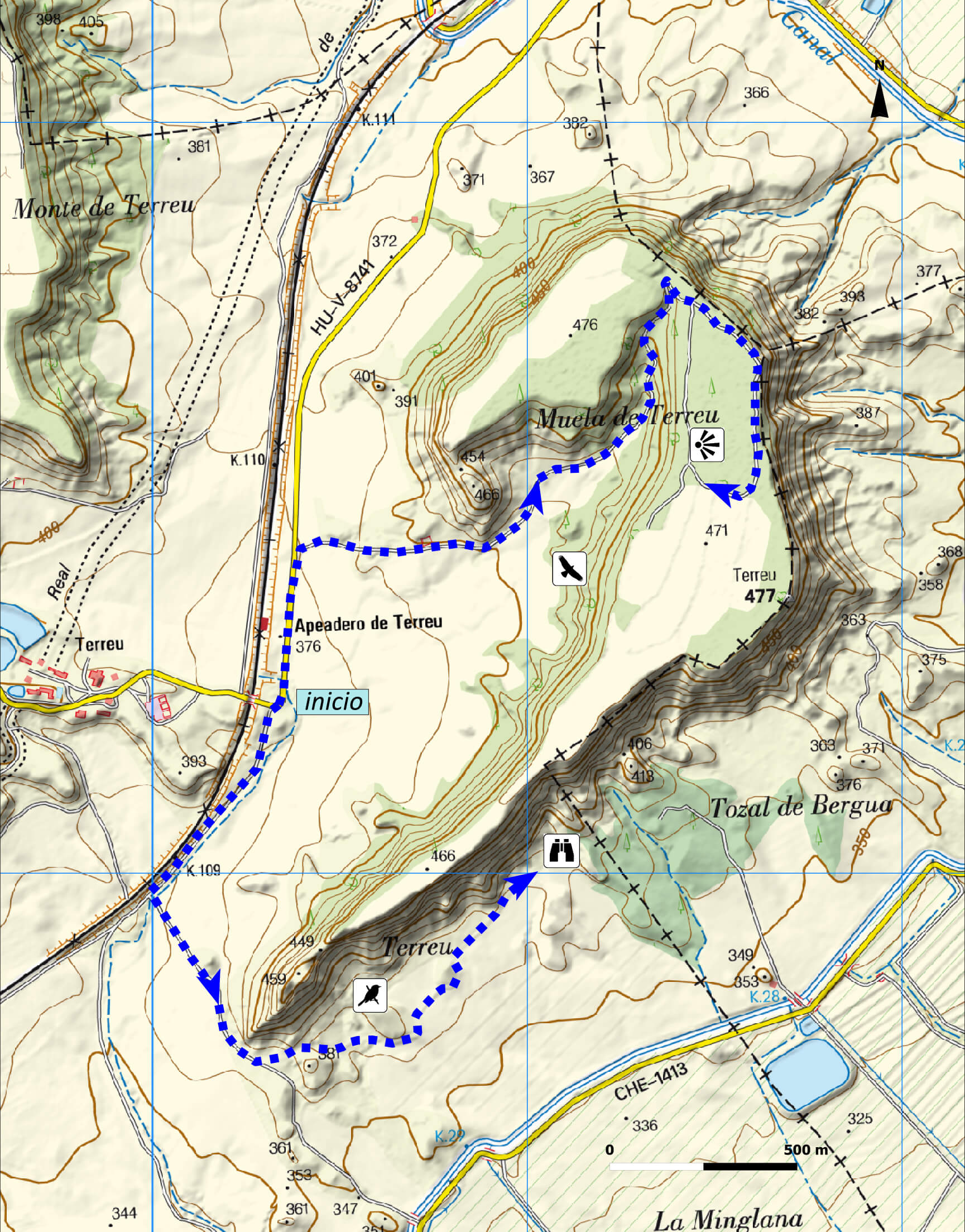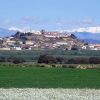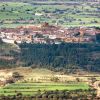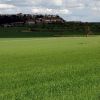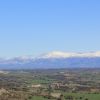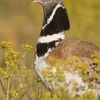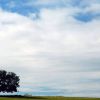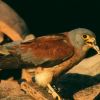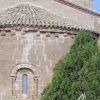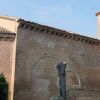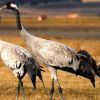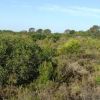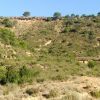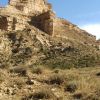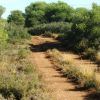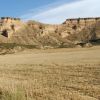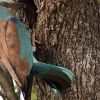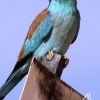Ecosistema Estepareo
Technical information
Type of route: return hiking route
Departure point: Berbegal
KM: 15,6
Duration: 4 h
Gradient: 55 m
MIDE: 1-1-2-3
Difficulty:
Access
From Barbastro, take the road A-1226 heading towards Berbegal. In Berbegal take route GR-45 (which starts near the council scale) and continue eastwards, always leading to the village of Lacuadrada (end of the itinerary).
Route description
The route begins at Berbegal along the path (GR 45) next to the council scale that leads us to the centre of Lacuadrada (end of itinerary). We will return along the same track. The 7,8 km round course can be undertaken on foot, by bike or in a four-wheeled vehicle. The route runs along a plain consisting of cereal fields with fallow lands, with natural vegetation and some small holm-oak woodlands as well as almond crops. The best time to do this rute is spring or summer, when it is possible to observe European Roller, Little Bustard males and Lesser Kestrels.
Main Species
Representative bird: Little Bustard (Tetrax tetrax)
Residents: Golden Eagle (rare), Eurasian Buzzard, Western Marsh Harrier, Common Kestrel, Long-eared Owl, Little Owl, Red-legged Partridge, Eurasian Stone-curlew, Dartford Warbler (rare), Eurasian Tree Sparrow, Corn Bunting.
Summer migrants: Black Kite, Montagu’s Harrier, Eurasian Hobby, Lesser Kestrel, Little Bustard (in drought), Quail, Red-necked Nightjar, European Bee-eater, European Roller, Western Orphean Warbler, Spectacled Warbler, Subalpine Warbler, Black-eared Wheatear, Melodious Warbler, etc.
Winter visitors: Golden Eagle (sub-adults and young), Hen Harrier, Merlin, Little Bustard (in lucerne), Merlin, Lapwing, Song Thrush, Yellowhammer (rare).
Passage migrants: Common Crane, Northern Wheatear, Willow Warbler, Pied Flycatcher, etc.
Photo gallery
Map
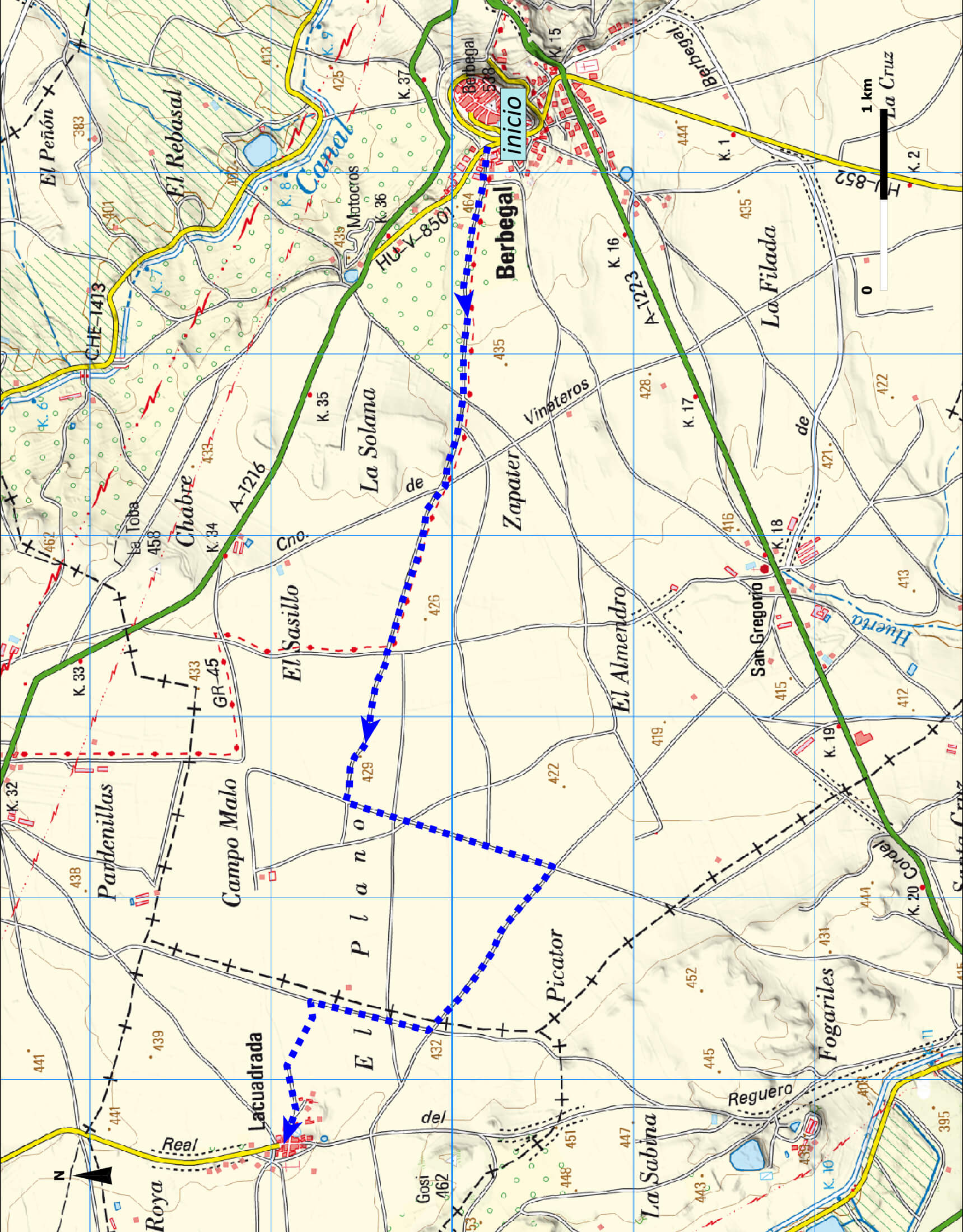
Technical information
Type of route: circular hiking route
Departure point: Peralta de Alcofea
KM: 11,4
Duraction: 3 h
Gradient: 15 m
MIDE: 1-2-2-2
Difficulty:
Access
From Barbastro, take the road A-1226 to Peralta de Alcofea. In Peralta de Alcofea take road A-1227 towards Tormillo-Terreu. After climbing up the saso through a thicket of pine trees (aproximately 5 km), take the North track on the left towards Lagunarrota.
Route description
In Peralta de Alcofea we take the road A-1227 towards Tormillo-Terreu. After climbing up the saso through a thicket of pine trees (approximately 5 km), we take the North track on the left. This track leads to Lagunarrota. Before we get there, we will return along another South track, completing the circular route. The route runs on a plain with cereal fields cultivated on fallow lands, natural vegetation plots and almond crops, where we can observe European Roller, Little Bustard and Lesser Kestrel.
Main Species
Representative bird: Lesser Kestrel (Falco naumanii)
Residents: Golden Eagle (rare), Eurasian Buzzard, Western Marsh Harrier, Common Kestrel, Long-eared Owl, Little Owl, Red-legged Partridge, Eurasian Stone-curlew, Dartford Warbler (rare), Eurasian Tree Sparrow, Corn Bunting.
Summer migrants: Black Kite, Montagu’s Harrier, Eurasian Hobby, Lesser Kestrel, Little Bustard (in drought), Quail, Red-necked Nightjar, European Bee-eater, European Roller, Western Orphean Warbler, Spectacled Warbler, Subalpine Warbler, Black-eared Wheatear, Melodious Warbler, etc.
Winter visitors: Golden Eagle (sub-adults y youngs), Hen Harrier, Merlin, Little Bustard (in lucerne), Merlin, Song Thrush, European Robin, Chaffinch, Brambling, Hawfinch, Rock Bunting, Yellowhammer, Reed Bunting.
Passage migrants: Common Crane, Northern Wheatear, Willow Warbler, Pied Flycatcher, etc.
Photo gallery
Map
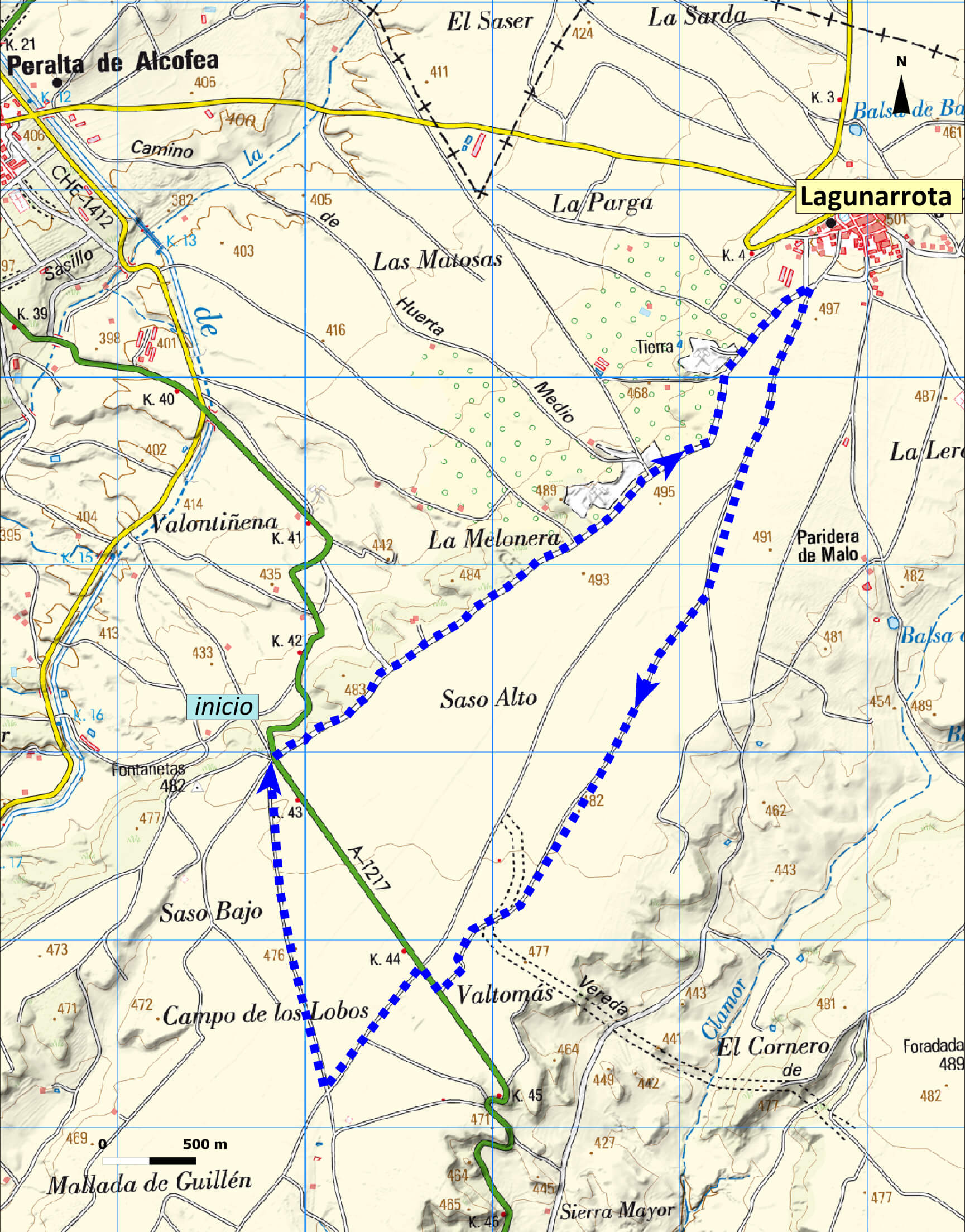
Technical information
Type of route: return hiking route
Departure point: Monesma
KM: 4
Duration: 1 h
Gradient: 40 m
MIDE: 1-1-1-1
Difficulty:
Access
From Barbastro, take road A-1226 towards Monesma (16 km). In Monesma take the dirt track leading to Selgua (NE) until you cross another track opposite to the rice fields where are located the Cranes roosting sites. At that observation spot, park your car and keep on walking on foot if you want to come closer to the rice fields.
Route description
The route begins in Monesma, taking road HU-V-8742 towards Selgua (NE), across lucerne, corn and rice fields. In a short course of about 4 km, we can observe, at different times of the year, waders such as the European Golden Plover, Hen Harrier, Merlin and Lapwing. After just 2,1 km, at a junction where we can park the car, it is possible to observe a Common Crane roost, in southeast direction among the rice fields. From there, you can come back on foot bordering these fields, in case you want to get closer to the Cranes.
Main Species
Representative bird: Common Crane (Grus grus)
Residents: Mallard, Grey Heron, Cattle Egret, Eurasian Buzzard, Western Marsh Harrier, Common Kestrel, Long-eared Owl, Little Owl, Red-legged Partridge, Eurasian Stone-curlew, Common Sandpiper, Zitting Cisticola, Cetti’s Warbler, Sardinian Warbler, Rock Sparrow, Linnet, Goldfinch, European Serin, Western Jackdaw, Carrion Crow, Raven, Corn Bunting.
Summer migrants: Purple Heron, Black Kite, Egyptian Vulture, Eurasian Hobby, Quail, Great Spotted Cuckoo, Eurasian Scops Owl, Red-necked Nightjar, European Bee-eater, European Roller, Nightingale, Subalpine Warbler, Black-eared Wheatear, Melodious Warbler, etc.
Winter visitors: Great White Egret, Eurasian Bittern (rare), Hen Harrier, Merlin, Red Kite, Common Crane, Song Thrush, European Robin, Chaffinch, Reed Bunting.
Passage migrants: Greylag Goose, Anatidae, Black Stork, European Golden Plover, Eurasian Curlew, Green Sandpiper, Wood Sandpiper, Whinchat, Northern Wheatear, Willow Warbler, Pied Flycatcher, etc.
Photo gallery
Map
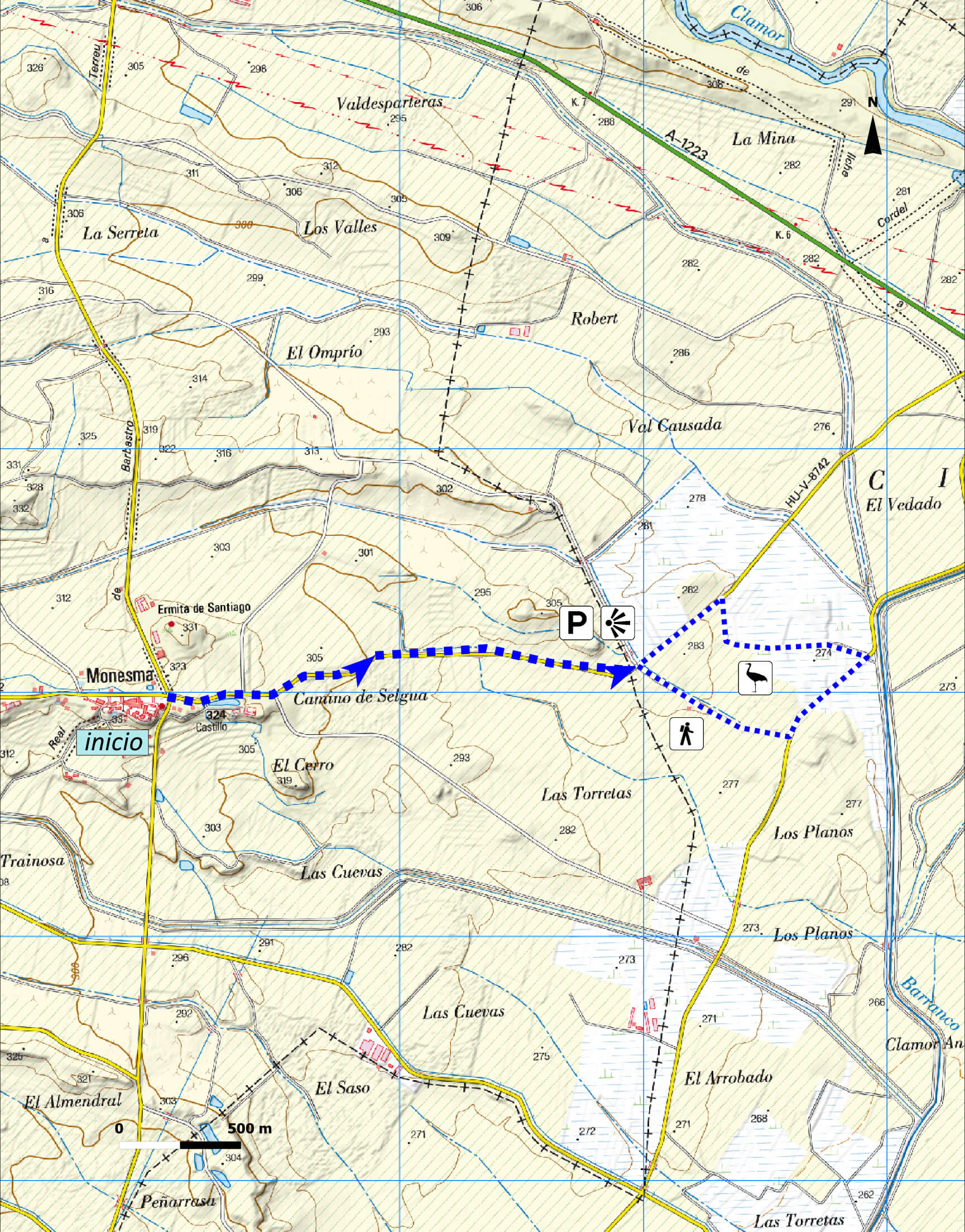
Technical information
Type of route: return hiking route
Departure point: Terreu
KM: 10
Duration: 3 h
Gradient: 100 m
MIDE: 1-2-2-2
Difficulty:
Access
From Barbastro, take road A-1226 to Monesma (16 km). In Monesma follow the signposts towards Terreu until you cross the railway track (10 km). Once there, turn right (West direction) and go on for approximately 2, 2 km, then park the car on one side. Both itineraries begin at that point.
Route description
Both routes begin at the junction between the main road (HU-V-8741) and the road that gives access to Terreu. The first route heads North, walking up through a path until La Muela de Terreu. It is possible to observe Lesser Whitethroats during the entire course and the feeding area of large predators on the crest. The second route heads towards the South and continues bordering La muela, through cereal fields on which we can observe Alpine Chough, Western Jackdaw, Blue Rock Thrush and Black Wheatear.
Main Species
Representative bird: European Roller (Coracias garrulus)
Residents: Golden Eagle, Griffon Vulture, Eurasian Buzzard, Western Marsh Harrier, Common Kestrel, Long-eared Owl, Little Owl, Red-legged Partridge, Black-bellied Sandgrouse, Eurasian Stone-curlew, Black Wheatear, Blue Rock Thrush, Dartford Warbler, Rock Sparrow, Alpine Chough, Western Jackdaw, Carrion Crow, Raven, Corn Bunting.
Summer migrants: Egyptian Vulture, Black Kite, Montagu’s Harrier, Eurasian Hobby, Lesser Kestrel, Little Bustard (in drought), Quail, Great Spotted Cuckoo, Red-necked Nightjar, European Bee-eater, European Roller, Bonelli’s Warbler, Western Orphean Warbler, Spectacled Warbler, Subalpine WarblerBlack-eared Wheatear, Melodious Warbler, etc.
Winter visitors: Golden Eagle (sub-dults and young), Hen Harrier, Merlin, Song Thrush, European Robin, Chaffinch, Brambling, Hawfinch, Rock Bunting, Yellowhammer, Reed Bunting.
Passage migrants: Common Crane, Northern Wheatear, Willow Warbler, Pied Flycatcher,etc.
Photo gallery
Map
